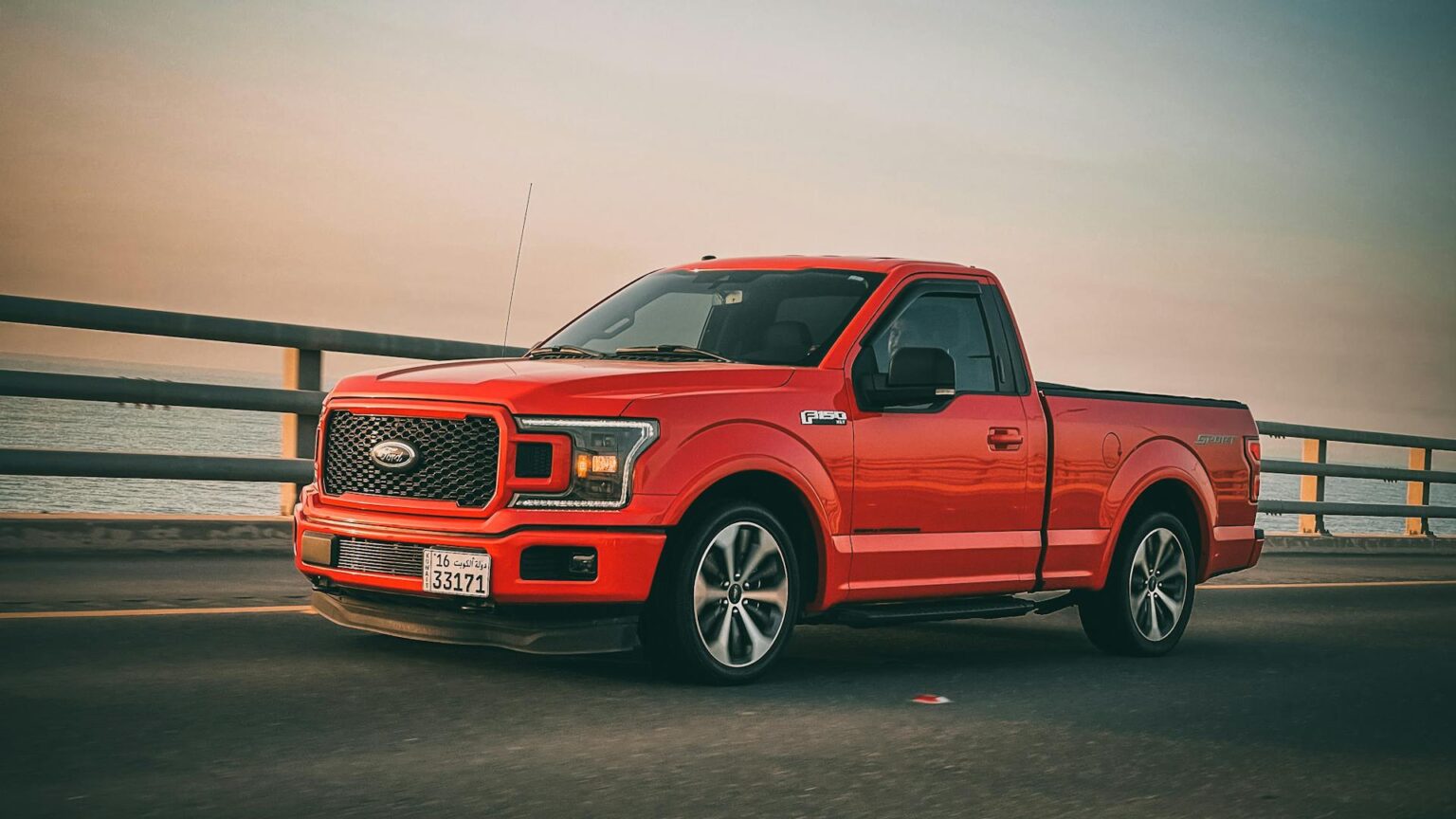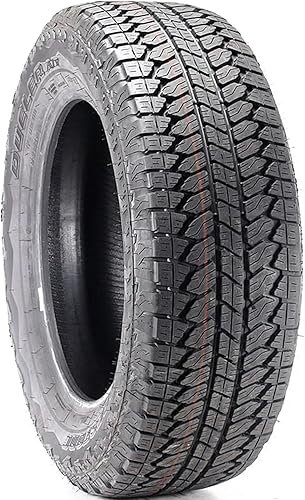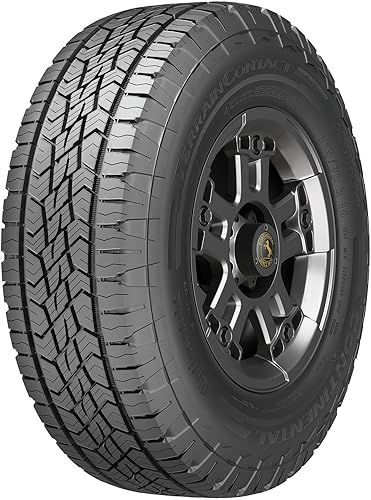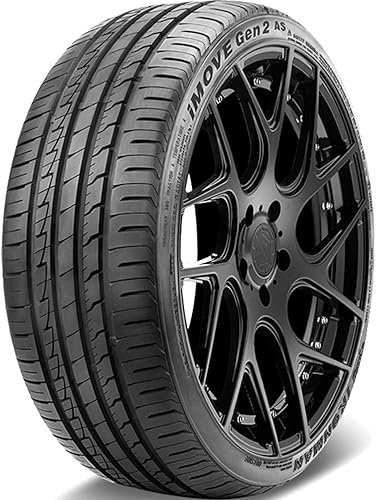If you’re gearing up your Ford F‑150 for dependable all-season performance—covering everything from dry pavement to rainy highways and light winter conditions—this guide narrows down the top five all-season tyres built for the job. After a careful review of tread life, ride comfort, noise levels and wet-weather grip, our clear standout pick is the Falken Wildpeak A/T Trail 225/65R17 102H All Terrain Light Truck Tire – a top-tier choice recognised for its smooth ride, strong all-season traction and durability.
Best 5 All Season Tires for for f150
01. Falken Wildpeak A/T Trail 225/65R17 102H All Terrain Light Truck Tire
The Falken Wildpeak A/T Trail 225/65R17 102H All Terrain Tire is made for drivers who like switching between highways and rough backroads without worrying about performance drop-offs. Designed mainly for crossovers and light trucks, it brings a nice balance of comfort, traction, and toughness. The tread pattern holds grip on wet asphalt and loose gravel alike, and its silica-based compound helps resist wear even under hot or cold weather. If you’re driving something like a Toyota RAV4, Subaru Forester, or Honda CR-V, this tire feels at home both on city roads and mountain trails.
✅ Pros:
- Excellent grip on dry, wet, and light snow surfaces
- Tough sidewalls for better puncture resistance
- Smooth ride with low road noise for an all-terrain tire
- Works well with AWD crossovers and compact SUVs
❌ Cons:
- Slightly firmer feel compared to standard touring tires
- May not perform as well in deep mud or heavy off-road terrains
The Wildpeak A/T Trail fits drivers who need an all-terrain tire but still spend most of their time on pavement. It carries Three-Peak Mountain Snowflake (3PMSF) certification, which means it’s built to handle light snow and cold-weather traction better than many competitors. Its tread life and handling stability make it a solid pick for those who want confidence year-round without switching tires seasonally.
02. Bridgestone Dueler A/T RH-S All Terrain SUV Tire
The Bridgestone Dueler A/T RH-S All Terrain SUV Tire is built for those who don’t like to stay confined to smooth city roads. Designed for SUVs and light trucks, it handles gravel, mud, and pavement with a quiet stubbornness that feels reassuring. The tread design provides good grip even on wet surfaces, and its strong sidewalls help prevent punctures when you’re driving off-road or hauling heavy loads. Drivers who use it on vehicles like the Toyota Highlander, Ford Explorer, or Chevy Tahoe often praise its steady road feel during both highway cruising and rougher terrain.
✅ Pros:
- Durable tread compound for long mileage and mixed terrain use
- Strong traction on wet and dry roads
- Smooth, quieter ride for an all-terrain tire
- Works well for SUVs and light trucks like Ford F-150 and Chevy Silverado
❌ Cons:
- Not the best performer in deep snow conditions
- Slightly higher price compared to similar all-terrain tires
If you want a dependable all-season SUV tire that doesn’t give up when the road turns messy, the Bridgestone Dueler A/T RH-S fits right in the middle—rugged enough for adventure yet civilized enough for daily drives.
03. MICHELIN Defender2 All-Season Tire
The MICHELIN Defender2 All-Season Tire is built for folks who want a tire that just keeps rolling — quietly, smoothly, and for a long time. Designed for sedans, minivans, and SUVs, it uses an advanced tread compound that holds up against both heat and wear, especially in unpredictable weather. Drivers often say it grips confidently on wet roads, while still handling long highway drives without that usual humming noise you get with older tires. The tread pattern is tuned for even contact pressure, which means more consistent wear and less of that annoying vibration as the miles pile up.
✅ Pros:
- Long tread life, backed by one of the best mileage warranties in its class
- Strong traction on wet and dry pavement
- Smooth and quiet ride comfort for daily commuting
- Durable design suitable for family vehicles and long-distance drives
❌ Cons:
- Higher price tag compared to budget all-season tires
- Not the best performer in heavy snow or icy conditions
If you drive a Toyota RAV4, Honda CR-V, or Ford F-150, this tire fits right into the mix of reliability and comfort that Michelin is known for. It’s part of the Defender lineup, which focuses on long-lasting performance without compromising safety — ideal for anyone who doesn’t want to replace tires every couple of years.
04. CONTINENTAL TerrainContact A/T All-Terrain Radial Tire
The CONTINENTAL TerrainContact A/T All-Terrain Radial Tire is built for those who expect their tires to hold up on both highways and unpaved trails. Known for its quiet, comfortable ride, this tire blends durability with control—something you’ll appreciate whether you’re hauling loads or heading out for weekend adventures. The tread design grips firmly on gravel and dirt but doesn’t punish you with noise or stiffness on city roads. It’s also engineered with Continental’s TractionPlus Technology, which helps maintain strong contact and reduce wear, even under rough conditions.
✅ Pros:
- Strong all-terrain performance with good traction on dry, wet, and light snow surfaces.
- Quiet and smooth on highways compared to most A/T tires.
- Excellent tread life with durable compound and cut-resistant design.
- Enhanced grip and braking stability for light trucks, SUVs, and crossovers.
❌ Cons:
- Slightly pricier than other all-terrain tire options.
- Not ideal for deep mud or extreme off-road terrains.
05. Ironman iMove Gen 2 A/S all_ Season Radial Tire
The Ironman iMove Gen 2 A/S All-Season Radial Tire is a solid choice for drivers who want a dependable, budget-friendly tire without cutting corners on grip and comfort. Its asymmetric tread pattern gives it good handling stability on dry and wet roads, while the large shoulder blocks help with cornering and braking. It’s made with a silica-enhanced compound that boosts traction even when the temperature drops. For daily commutes or highway drives, this tire holds its own, especially for sedans and compact SUVs.
✅ Pros:
- Strong dry and wet traction for an all-season tire
- Quiet and smooth ride quality even at higher speeds
- Affordable compared to other all-season tire brands
- Good cornering stability thanks to wide shoulder design
❌ Cons:
- Tread life could be better for aggressive drivers
- Limited winter performance in heavy snow or icy conditions
Overall, the Ironman iMove Gen 2 A/S tire fits well for those seeking a practical, cost-effective option for all-season driving. Its mix of traction, comfort, and control makes it a reasonable pick for vehicles like the Toyota RAV4, Honda CR-V, or Ford Fusion, where balanced road performance matters more than premium branding.
How to Choose the Best Tires for F150
Sometimes you look at your Ford F150 and think, these tires… they’ve seen better days. Maybe you don’t even realize how much grip you’ve lost until one wet corner reminds you with that small heart-jump moment. Tires, man—they’re not glamorous, but they’re the quiet deal-breaker between comfort, control, and chaos. The thing is, choosing the best tires for an F150 isn’t as easy as walking into a store and saying, “give me the good ones.” Because the good ones for someone towing a horse trailer in Texas heat are not the same as the good ones for someone sliding through icy Wisconsin roads.
The weight of truck
The F150 isn’t a sedan. It’s a hefty piece of machinery. A half-ton pickup, sure, but depending on configuration, you’re talking about a curb weight between roughly 4,000 to 5,700 pounds, and that’s before the tools, the load, or your weekend toys go in the back. Tires made for SUVs sometimes look tempting—slick designs, fancy tread names—but they’ll squish under a heavy truck when you’re towing. You need Load Range C or E tires, depending on how much you haul. Many folks ignore this part, thinking it’s overkill. But under-inflated or overloaded tires? That’s how sidewalls bulge and blowouts happen on I-40 when it’s 105°F and you’ve still got 80 miles to go.
I once saw a guy at a gas station pumping up his rear tires with one of those small compressors that sound like a mosquito. Said he “just switched to E-rated tires for towing.” His face had that mix of pride and regret. E-rateds are stiff. They make your ride rougher on city streets. But they’ll handle serious weight without flinching.
Terrain
Most people say “All-Terrain” because it sounds cool. But it’s like ordering medium-spicy curry when you can’t handle spice—you regret it halfway in. All-Terrain (A/T) tires look aggressive, sure, with chunky lugs and deep voids. They’re built for gravel, mud, and snow. But on highways, they hum, they sip more fuel, and they wear unevenly if you’re mostly driving on pavement.
If you live somewhere dry and flat, something like the All-Season or Highway Terrain (H/T) might just be smarter. They’re quieter, smoother, and last longer. But if your weekends mean dirt trails or construction sites, then A/T tires earn their keep. Some even have 3-Peak Mountain Snowflake ratings, meaning they’re snow-certified, unlike regular all-seasons that panic when flakes fall.
And then there’s Mud-Terrain (M/T)—the wild cousins. Those belong to the off-road junkies. They’re not meant for daily city commute unless you love noise.
Numbers and stats
Most F150 owners don’t think about treadwear ratings, but they should. A tire rated 500 might last twice as long as one rated 250 under similar conditions. Then you’ve got traction (A, AA, B, C) and temperature resistance ratings. You don’t need to memorize them, but a quick glance can tell you if you’re buying a long-distance companion or a fling.
Also, tire pressure—people underestimate it. The F150’s sweet spot usually hangs around 35 PSI, but it varies depending on load. Underinflated tires increase rolling resistance, burning fuel like a bonfire. Overinflate, and your traction goes out the window.
Statistics from the National Highway Traffic Safety Administration once showed that underinflated tires cause around 11,000 accidents every year in the U.S. It’s boring maintenance stuff, but it keeps trucks and lives intact.
The brands that get mentioned at every barbecue
Ask ten truck owners, and you’ll get ten different answers. Michelin Defender LTX M/S, Goodyear Wrangler All-Terrain Adventure, BFGoodrich KO2, General Grabber A/TX, Falken Wildpeak A/T3W, maybe even a Bridgestone Dueler Revo if they drive in mixed terrain.
The names come up because they’ve earned a kind of legend status. Michelin’s known for road manners and longevity, BFG for toughness, Goodyear for balance, Falken for that perfect middle-ground pricing.
But no brand’s perfect. KO2s are tough but noisy. Defenders are smooth but pricey. Grabbers look mean but can wear faster if misaligned. So, there’s no universal “best.” Just what fits your mix of use, climate, and tolerance for noise.
Weather plays dirty tricks
Heat expands air. Cold shrinks it. Simple science. But when you’re running 70 mph on a Texas freeway in August, that matters. Rubber softens. Pressure climbs. In winter, it’s the opposite—rubber hardens, grip fades. If you live where snow blankets the road five months a year, winter tires aren’t optional. You can’t fake traction on black ice.
I’ve seen folks brag about “never needing snow tires” right up until their F150 slides sideways in a parking lot at 5 mph. Pride hurts less than repair bills.
Yeah, aesthetics matter
Some people won’t admit it, but they choose tires the same way others choose shoes. You can tell a lot from a truck’s stance. Beefy tread patterns, white lettering on the sidewalls, raised profiles—they change the whole character. It’s not just vanity either. Slightly bigger tires (within reason) can improve ground clearance and fill wheel wells nicely. Just remember, upsizing too much messes with your speedometer calibration and fuel efficiency.
Price and lifespan
Tires aren’t cheap anymore. A decent set for an F150 can cost anywhere between $700 to $1,400, depending on type and brand. The trick is thinking in years, not dollars. A $1,200 set that lasts 70,000 miles beats an $800 one that burns out at 35,000. But people forget that math because it’s invisible—wear happens slow, quietly.
There’s also rotation. Every 5,000–6,000 miles, ideally. Neglect it, and even the best tires wear unevenly. A tire warranty means nothing if your maintenance record looks lazy.
Final thought?
Picking the best tires for an F150 isn’t about brands or fancy tread names—it’s about matching your habits, your terrain, your patience. And maybe being honest about whether your truck’s a weekend warrior or a daily workhorse. You can argue brands all night, but the best tire is the one that fits your story, not someone else’s review.






